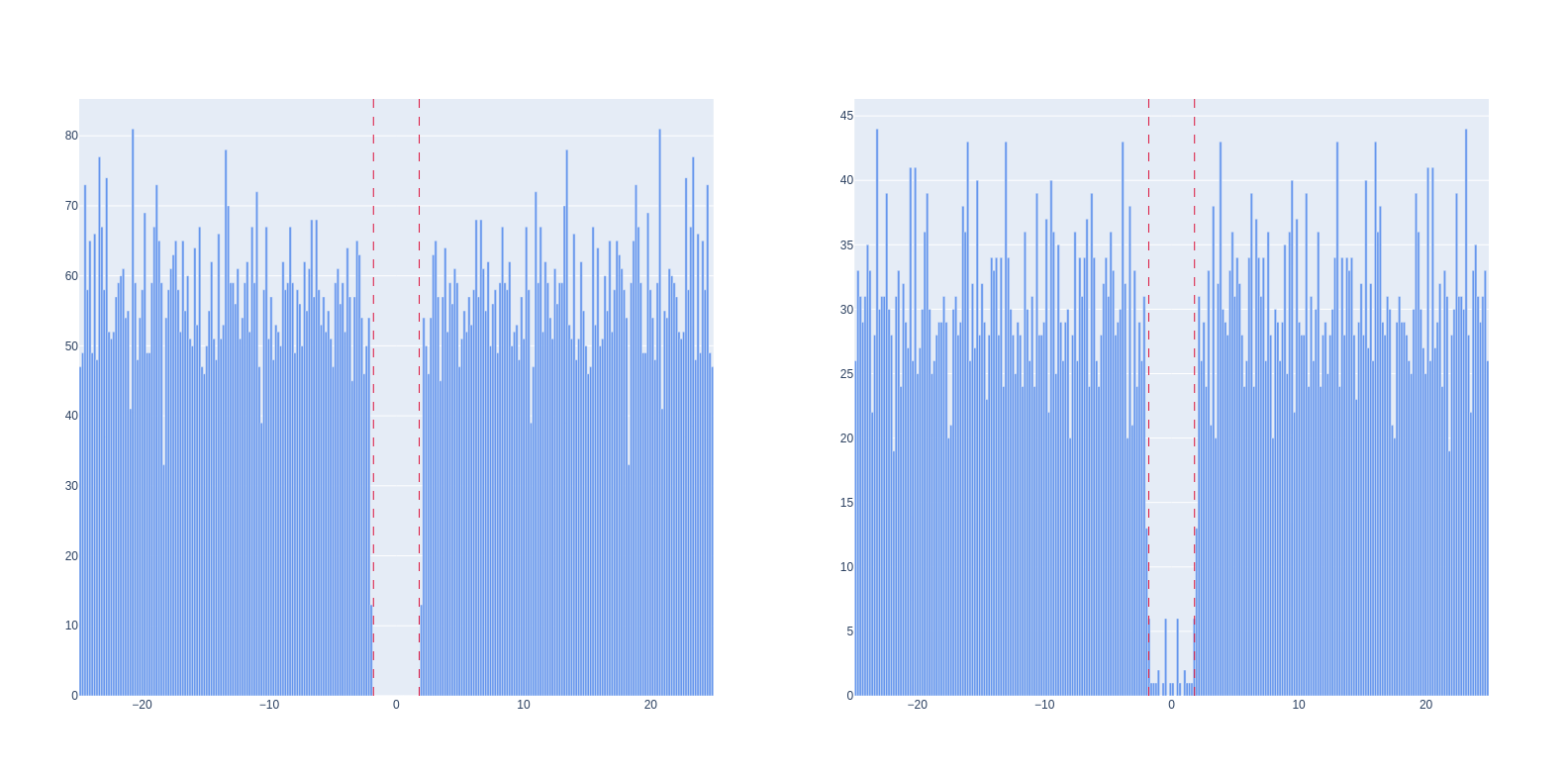Inter-spike-interval (ISI) violations (isi_violation, rp_violation)¶
Calculation¶
Neurons have a refractory period after a spiking event during which they cannot fire again. Inter-spike-interval (ISI) violations refers to the rate of refractory period violations (as described by [Hill]).
The calculation works under the assumption that the contaminant events happen randomly or come from another neuron that is not correlated with our unit. A correlation will lead to an overestimation of the contamination, whereas an anti-correlation will lead to an underestimation.
Different formulas have been developed over the years.
Calculation from the [Hill] paper¶
The following quantities are required:
\(ISI_t\) : biological threshold for ISI violation.
\(ISI_{min}\): minimum ISI threshold enforced by the data recording system used.
\(ISI_s\) : the array of ISI violations which are observed in the unit’s spike train.
\(\#\): denotes count.
The threshold for ISI violations is the biological ISI threshold, \(ISI_t\), minus the minimum ISI threshold, \(ISI_{min}\) enforced by the data recording system used. The array of inter-spike-intervals observed in the unit’s spike train, \(ISI_s\), is used to identify the count (\(\#\)) of observed ISI’s below this threshold. For a recording with a duration of \(T_r\) seconds, and a unit with \(N_s\) spikes, the rate of ISI violations is:
Calculation from the [Llobet] paper¶
The following quantities are required:
\(T\) the duration of the recording.
\(N\) the number of spikes in the unit’s spike train.
\(t_r\) the duration of the unit’s refractory period.
\(n_v\) the number of violations of the refractory period.
The estimated contamination \(C\) can be calculated with 2 extreme scenarios. In the first one, the contaminant spikes are completely random (or come from an infinite number of other neurons). In the second one, the contaminant spikes come from a single other neuron:
Where \(TP\) is the number of true positives (detected spikes that come from the neuron) and \(FP\) is the number of false positives (detected spikes that don’t come from the neuron).
Expectation and use¶
ISI violations identifies unit contamination - a high value indicates a highly contaminated unit. Despite being a ratio, ISI violations can exceed 1 (or become a complex number in the [Llobet] formula). This is usually due to the contaminant events being correlated with our neuron, and their number is greater than a purely random spike train.
Example code¶
Without SpikeInterface:
spike_train = ... # The spike train of our unit
t_r = ... # The refractory period of our unit
n_v = np.sum(np.diff(spike_train) < t_r)
# Use the formula you want here
With SpikeInterface:
import spikeinterface.qualitymetrics as sqm
# Combine sorting and recording into sorting_analyzer
isi_violations_ratio, isi_violations_count = sqm.compute_isi_violations(sorting_analyzer=sorting_analyzer, isi_threshold_ms=1.0)
References¶
Hill implementation (isi_violation)¶
- spikeinterface.qualitymetrics.misc_metrics.compute_isi_violations(sorting_analyzer, isi_threshold_ms=1.5, min_isi_ms=0, unit_ids=None)¶
Calculate Inter-Spike Interval (ISI) violations.
- It computes several metrics related to isi violations:
- isi_violations_ratio: the relative firing rate of the hypothetical neurons that are
generating the ISI violations. Described in [Hill]. See Notes.
isi_violation_count: number of ISI violations
- Parameters
- sorting_analyzerSortingAnalyzer
The SortingAnalyzer object
- isi_threshold_msfloat, default: 1.5
Threshold for classifying adjacent spikes as an ISI violation, in ms. This is the biophysical refractory period
- min_isi_msfloat, default: 0
Minimum possible inter-spike interval, in ms. This is the artificial refractory period enforced by the data acquisition system or post-processing algorithms.
- unit_idslist or None
List of unit ids to compute the ISI violations. If None, all units are used.
- Returns
- isi_violations_ratiodict
The isi violation ratio described in [Hill].
- isi_violation_countdict
Number of violations.
Notes
You can interpret an ISI violations ratio value of 0.5 as meaning that contaminating spikes are occurring at roughly half the rate of “true” spikes for that unit. In cases of highly contaminated units, the ISI violations ratio can sometimes be greater than 1.
References
Based on metrics described in [Hill]
Originally written in Matlab by Nick Steinmetz (https://github.com/cortex-lab/sortingQuality) and converted to Python by Daniel Denman.
LLobet implementation (rp_violation)¶
- spikeinterface.qualitymetrics.misc_metrics.compute_refrac_period_violations(sorting_analyzer, refractory_period_ms: float = 1.0, censored_period_ms: float = 0.0, unit_ids=None)¶
Calculates the number of refractory period violations.
This is similar (but slightly different) to the ISI violations. The key difference being that the violations are not only computed on consecutive spikes.
This is required for some formulas (e.g. the ones from Llobet & Wyngaard 2022).
- Parameters
- sorting_analyzerSortingAnalyzer
The SortingAnalyzer object
- refractory_period_msfloat, default: 1.0
The period (in ms) where no 2 good spikes can occur.
- censored_period_msfloat, default: 0.0
The period (in ms) where no 2 spikes can occur (because they are not detected, or because they were removed by another mean).
- unit_idslist or None
List of unit ids to compute the refractory period violations. If None, all units are used.
- Returns
- rp_contaminationdict
The refactory period contamination described in [Llobet].
- rp_violationsdict
Number of refractory period violations.
Notes
Requires “numba” package
References
Based on metrics described in [Llobet]
Examples with plots¶
Here is shown the auto-correlogram of two units, with the dashed lines representing the refractory period.
On the left, we have a unit with no refractory period violations, meaning that this unit is probably not contaminated.
On the right, we have a unit with some refractory period violations. It means that it is contaminated, but probably not that much.

This figure can be generated with the following code:
import plotly.graph_objects as go
from spikeinterface.postprocessing import compute_correlograms
# Create your sorting object
unit_ids = ... # Units you are interested in vizulazing.
sorting = sorting.select_units(unit_ids)
t_r = 1.5 # Refractory period (in ms).
correlograms, bins = compute_correlograms(sorting, window_ms=50.0, bin_ms=0.2, symmetrize=True)
fig = go.Figure().set_subplots(rows=1, cols=2)
fig.add_trace(go.Bar(
x=bins[:-1] + (bins[1]-bins[0])/2,
y=correlograms[0, 0],
width=bins[1] - bins[0],
marker_color="CornflowerBlue",
name="Non-contaminated unit",
showlegend=False
), row=1, col=1)
fig.add_trace(go.Bar(
x=bins[:-1] + (bins[1]-bins[0])/2,
y=correlograms[1, 1],
width=bins[1] - bins[0],
marker_color="CornflowerBlue",
name="Contaminated unit",
showlegend=False
), row=1, col=2)
fig.add_vline(x=-t_r, row=1, col=1, line=dict(dash="dash", color="Crimson", width=1))
fig.add_vline(x=t_r, row=1, col=1, line=dict(dash="dash", color="Crimson", width=1))
fig.add_vline(x=-t_r, row=1, col=2, line=dict(dash="dash", color="Crimson", width=1))
fig.add_vline(x=t_r, row=1, col=2, line=dict(dash="dash", color="Crimson", width=1))
fig.show()
Links to original implementations¶
Literature¶
Introduced by [Hill] (2011). Also described by [Llobet] (2022)